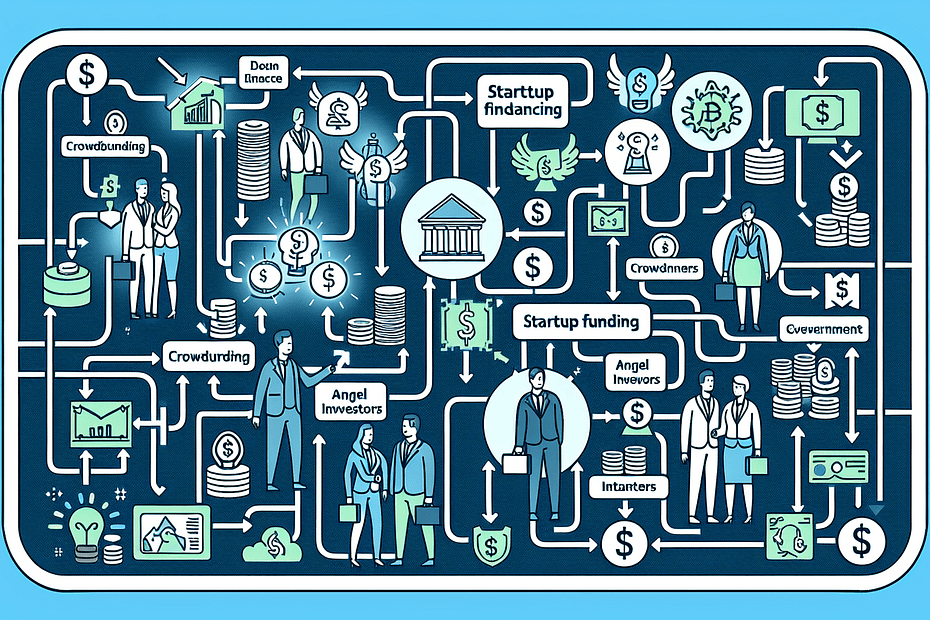So, you’ve launched your own startup, and now you’re on the hunt for funding options to take your business to the next level. But with so many choices out there, it can be overwhelming to navigate through the maze of options. Well, fear not! In this article, we’ll break down the latest funding options available for startups, giving you a rundown on everything from traditional methods like bank loans to more modern alternatives like crowdfunding and venture capital. By the end, you’ll have a clear understanding of the funding landscape and be well-equipped to make an informed decision for your startup’s financial future.
Venture Capital
Overview of Venture Capital
Venture capital refers to a type of financing provided to early-stage, high-potential companies by investors who are willing to take on high risks in exchange for equity or ownership in the company. Startups often turn to venture capital funding when they require a substantial amount of capital to fuel their growth and expansion plans. Unlike traditional bank loans, venture capital funding does not require the borrower to make regular repayments, but rather offers the investors the potential for significant returns through the eventual sale of their equity stake in the company.
Benefits of Venture Capital Funding
Venture capital funding offers various benefits to startups, making it an attractive option for entrepreneurs. One of the key benefits is the infusion of capital that can support business operations, hiring talent, research and development, and marketing efforts. In addition, venture capitalists often bring valuable industry expertise and connections to the table, which can greatly benefit startups in terms of strategic guidance and networking opportunities. Moreover, venture capital funding can provide startups with credibility, as the backing of reputable investors can enhance the company’s reputation and help attract further investment or partnership opportunities.
Process of Securing Venture Capital Funding
Securing venture capital funding requires a well-planned approach. Startups typically start the process by conducting rigorous market research and developing a compelling business plan that outlines their growth strategy and potential for financial returns. It is crucial to identify venture capital firms that align with the industry, stage of development, and funding requirements of the startup. Once potential investors have been identified, entrepreneurs need to prepare a comprehensive pitch deck that effectively communicates their business model, market opportunity, competitive advantage, and financial projections. If the pitch generates interest, the startup will engage in negotiations with the venture capital firm, discussing terms such as valuation, equity share, and board representation. Finally, due diligence is conducted, and if successful, a legally binding agreement is reached, and the funds are disbursed.
Top Venture Capital Firms
The venture capital landscape is vast, with numerous firms providing funding to startups across various industries. Some of the top venture capital firms include Sequoia Capital, Accel, Andreessen Horowitz, Kleiner Perkins, and Bessemer Venture Partners. These firms have a proven track record of supporting successful startups and have established themselves as key players in the industry. However, it is important for entrepreneurs to research and identify venture capital firms that align with their specific industry and growth goals.
Angel Investors
Introduction to Angel Investors
Angel investors, also known as private investors or angel funders, are affluent individuals who provide financial backing to startups in exchange for equity ownership or convertible debt. They typically invest their own personal funds, often in the early stages of a company’s development when it is considered riskier by traditional investors. Angel investors can offer not only financial support but also valuable expertise, industry connections, and mentorship, making them a valuable resource for startups.
Advantages of Angel Investors
There are several advantages to securing funding from angel investors. Firstly, the process is often faster and more flexible compared to securing funding from traditional institutions. Angel investors are more willing to take risks by investing in early-stage startups that may have limited financial history or collateral. Additionally, angel investors often bring a wealth of industry experience and expertise to the table, providing startups with valuable guidance and mentorship. Unlike venture capital firms, angel investors tend to have a more hands-on approach, actively participating in the decision-making process and helping to steer the startup in the right direction. Furthermore, angel investors can open doors to additional funding sources and strategic partnerships, leveraging their extensive networks for the benefit of the startup.
How to Find Angel Investors
Finding angel investors requires some research and networking. Networking events, industry conferences, and startup pitch competitions are great places to meet potential angel investors. Online platforms and networks specific to angel investing, such as AngelList and Gust, can also connect startups with interested investors. Moreover, entrepreneurs should utilize their existing networks and connections, reaching out to colleagues, friends, and mentors who may be able to introduce them to potential angel investors. It is essential to thoroughly research and vet angel investors before entering into any agreements, ensuring they align with the startup’s goals, values, and industry focus.
Tips for Pitching to Angel Investors
When pitching to angel investors, it is important to remember that they are not only interested in the business idea but also in the entrepreneur behind it. Therefore, the pitch should not only focus on the product or service but also highlight the expertise and passion of the founders. Additionally, startups should clearly articulate their market opportunity, competitive advantage, and potential for scalability and financial returns. Presenting a well-researched business plan, including financial projections and a clear roadmap, can help instill confidence in angel investors. It is also crucial to be prepared for tough questions and criticisms and to demonstrate a willingness to listen and learn from experienced investors. Finally, startups should always approach angel investors with professionalism and transparency, establishing a foundation of trust and open communication from the start.
Crowdfunding
What is Crowdfunding?
Crowdfunding is a relatively new and increasingly popular method of raising capital for startups and other projects. It involves raising small amounts of money from a large number of individuals, often through online platforms. Crowdfunding offers an alternative to traditional funding sources by leveraging the power of the crowd to finance innovative ideas and ventures.
Types of Crowdfunding
There are several types of crowdfunding, each with its own unique characteristics. Donation-based crowdfunding involves individuals making donations to support a cause or project they believe in, often in return for non-financial rewards or simply for the satisfaction of contributing. Reward-based crowdfunding allows individuals to contribute money in exchange for a predetermined reward or product, typically offered by the startup. Equity-based crowdfunding allows individuals to invest in a startup in exchange for shares or equity ownership in the company. Lastly, debt-based crowdfunding, also known as peer-to-peer lending, involves individuals lending money to the startup, typically with the expectation of receiving interest payments in return.
Popular Crowdfunding Platforms
There are numerous crowdfunding platforms available, each with its own target audience and focus. Kickstarter is one of the most well-known and widely used platforms, primarily for reward-based crowdfunding. Indiegogo is another popular platform that offers both donation-based and reward-based crowdfunding options. For equity-based crowdfunding, platforms such as SeedInvest and StartEngine provide opportunities for investors to support startups in exchange for equity. Debt-based crowdfunding platforms, such as LendingClub and Funding Circle, connect borrowers with individuals willing to lend money.
Tips for a Successful Crowdfunding Campaign
Running a successful crowdfunding campaign requires careful planning and execution. Firstly, startups should clearly define their goals and objectives for the campaign, including the amount of funding they are aiming to raise and how the funds will be utilized. It is important to create a compelling and engaging campaign page that clearly communicates the value proposition of the startup and the benefits for contributors. Utilizing high-quality visuals, videos, and storytelling can help captivate potential supporters and increase the chances of reaching the funding goal. Additionally, it is crucial to leverage existing networks and actively promote the campaign through social media, email marketing, and other channels to maximize visibility. Lastly, startups should keep their contributors engaged throughout the campaign by providing regular updates, offering exclusive incentives, and expressing gratitude for their support.
Business Incubators and Accelerators
What are Business Incubators and Accelerators?
Business incubators and accelerators are programs or organizations that provide support, resources, and mentorship to startups to help them develop and grow. While both incubators and accelerators aim to facilitate the success of startups, they differ in terms of their focus, duration, and structure.
Business incubators typically focus on nurturing startups in the early stages of development. They provide workspace, infrastructure, access to shared services, and networking opportunities. Incubators often have a longer duration, ranging from several months to a few years, during which startups receive ongoing support and guidance.
Business accelerators, on the other hand, are more intensive and fast-paced programs designed to accelerate the growth of startups that have already achieved a certain level of traction. Accelerators offer a structured curriculum, mentorship, and access to a network of industry experts and investors. The duration of accelerator programs is usually shorter, typically spanning several weeks to a few months.
Benefits of Joining Incubators and Accelerators
Joining a business incubator or accelerator can provide startups with several benefits. Firstly, startups gain access to a supportive community of like-minded entrepreneurs and experienced mentors who can offer guidance and industry expertise. The networking opportunities within these programs can facilitate valuable connections with potential investors, partners, and customers. Additionally, incubators and accelerators provide access to resources and facilities that may be otherwise unaffordable for startups, such as state-of-the-art office spaces, equipment, and software. Furthermore, the structured programs and mentorship offered in incubators and accelerators can help startups refine their business models, develop effective strategies, and navigate the challenges of scaling their operations.
How to Get Accepted into Incubators and Accelerators
Getting accepted into an incubator or accelerator program can be competitive, as these programs often receive a high number of applications. To increase the chances of acceptance, startups should thoroughly research and target programs that align with their industry, stage of development, and specific needs. It is essential to carefully review the eligibility criteria and application requirements of each program and tailor the application accordingly, highlighting the startup’s unique value proposition and potential for growth. Additionally, obtaining recommendations from industry experts or successful entrepreneurs who are familiar with the program can boost the credibility of the application. Lastly, startups should be prepared for the interview process, showcasing their passion, commitment, and coachability to program organizers.
Notable Incubators and Accelerators
There are numerous notable business incubators and accelerators around the world, each with its own unique offerings and success stories. Y Combinator, based in Silicon Valley, is one of the most prestigious and influential accelerators, known for nurturing startups such as Airbnb, Dropbox, and Stripe. Techstars, operating globally, has also supported many successful startups, including SendGrid and ClassPass. Other prominent incubators and accelerators include 500 Startups, Startupbootcamp, and AngelPad. It is important for startups to research and identify programs that align with their specific industry, location, and growth objectives.
Grants
Overview of Grants
Grants refer to non-repayable funds provided by government agencies, corporations, philanthropic organizations, and other entities to support specific projects, initiatives, or research. Unlike loans or equity investments, grants do not require repayment or the surrendering of ownership in the company. Grants can play a crucial role in funding the development of innovative ideas, research projects, and social initiatives.
Types of Grants
There are various types of grants available to startups, each with its own specific focus and eligibility criteria. Research and development grants are often provided to support scientific research and technological innovation. Startup grants aim to provide financial support to early-stage companies with the potential for high growth. Social impact grants focus on supporting initiatives that address social or environmental challenges. Furthermore, there are grants specifically targeted at minority-owned businesses, women-owned businesses, and businesses in underprivileged communities, aiming to promote diversity and inclusion in entrepreneurship.
Finding Grant Opportunities
Finding grant opportunities can be a challenging task, as the availability and criteria for grants vary by region and sector. Startups can start by exploring government websites, as many governments offer grants to support economic development and innovation. Researching philanthropic organizations, foundations, and corporations that align with the startup’s mission and values can also uncover potential grant opportunities. Additionally, startups should leverage their local business networks and industry associations, as they often have insights into grant programs and can provide guidance on the application process.
Application Process for Grants
The application process for grants typically varies depending on the granting organization. Startups should carefully review the eligibility criteria, guidelines, and deadlines provided by the grant program. It is important to thoroughly understand the objectives of the grant program and align the proposed project or initiative with those objectives. Startups should invest time and effort into crafting a compelling grant proposal, clearly outlining the problem or challenge they aim to address, their unique approach or solution, and the intended impact of the project. Providing a detailed budget and timeline can further enhance the credibility of the proposal. It is crucial to carefully follow the application instructions and submit all required documentation within the specified timeframe. After submitting the application, startups should be prepared for a waiting period, as grant programs often have a review and selection process before announcing the recipients.
Microloans
What are Microloans?
Microloans are small loans typically granted to individuals or small businesses that may not have access to traditional sources of financing. These loans are usually offered by nonprofit organizations, community development financial institutions (CDFIs), or online lenders. Microloans can be used for a variety of purposes, such as working capital, equipment purchases, inventory, or to start a new business venture.
Pros and Cons of Microloans
Microloans offer several advantages for startups and small businesses. Firstly, they provide access to capital for individuals who may have difficulty obtaining loans from conventional financial institutions due to limited credit history or collateral. Microloans often have more flexible requirements and are specifically designed to meet the needs of underserved entrepreneurs. Additionally, microloan programs often have educational and mentoring components, offering guidance and support to borrowers to increase their chances of success. However, microloans may have higher interest rates compared to traditional loans, reflecting the higher risk associated with lending to individuals or businesses with limited financial resources. Startups should carefully evaluate the terms and conditions of microloan programs to determine if they align with their financial capabilities and growth plans.
Providers of Microloans
Microloans are typically offered by nonprofit organizations, CDFIs, and some online lenders that specialize in serving underserved communities and supporting small businesses. Accion, an international microfinance organization, is one of the largest providers of microloans. Local community development organizations and credit unions may also offer microloan programs tailored to specific geographic areas. Online lenders such as Kiva and Opportunity Fund have digital platforms that connect borrowers with individual lenders who are willing to provide microloans.
Applying for a Microloan
Applying for a microloan usually involves a straightforward process, although specific requirements may vary among lenders. Start by researching and identifying lenders that specialize in microloans and align with the startup’s specific needs and geographic location. The application typically includes providing personal and financial information, such as credit history, income, and business plans. Some microloan programs may require the submission of additional documents, such as business licenses or financial statements. Applicants may be required to participate in interviews or workshops as part of the loan application process. Once the loan is approved, borrowers should carefully read and understand the loan agreement, including interest rates, repayment terms, and any additional fees.
Bootstrapping
Explanation of Bootstrapping
Bootstrapping refers to the practice of financing a startup or small business using personal savings, revenue generated by the business, or a combination of both, without seeking external funding from investors or lenders. Bootstrapping allows entrepreneurs to maintain full control of their businesses and avoid the obligations and potential dilution that can come with external funding.
Advantages and Disadvantages of Bootstrapping
Bootstrapping offers several advantages for startups. Firstly, it allows entrepreneurs to maintain full ownership and control of their business, enabling them to make independent decisions and execute their vision without external interference. Bootstrapping also allows for greater flexibility and agility, as entrepreneurs are not bound by the expectations or requirements of investors or lenders. Additionally, bootstrapping can foster a strong sense of resourcefulness and creativity, as entrepreneurs are forced to find innovative ways to stretch their limited resources. However, bootstrapping has its limitations. Startups may face challenges in accessing sufficient capital to support growth and expansion plans. Without external funding, the growth trajectory may be slower, and there may be a greater risk of financial instability or failure if the business encounters unexpected challenges.
Strategies for Bootstrapping
Startups can employ various strategies to effectively bootstrap their businesses and maximize their resources. Firstly, it is important to control costs by prioritizing essential expenses and adopting a lean approach to operations. This may involve minimizing overhead expenses, negotiating favorable deals with suppliers, or utilizing shared resources and services whenever possible. Additionally, generating revenue early on, even if it is initially modest, can help sustain the business and fund growth without relying heavily on external financing. Entrepreneurs should focus on identifying and capitalizing on revenue-generating opportunities and refining their business model to drive profitability. Moreover, building strategic partnerships and collaborations can offer access to valuable resources, expertise, and customers, thereby expanding the reach and impact of the business. Finally, continuously seeking feedback from customers and incorporating their input can help optimize products or services and increase customer satisfaction and loyalty.
Success Stories of Bootstrapped Startups
There have been numerous successful bootstrapped startups that have defied the odds and achieved remarkable growth and success. One notable example is Mailchimp, a leading marketing automation platform. Mailchimp was initially funded by its founder’s personal savings and steadily grew its customer base by delivering a valuable product with a strong focus on customer satisfaction. Another success story is GitHub, a widely used platform for software developers. GitHub was bootstrapped by its founders, who prioritized building a solid product and cultivating a supportive community. Their dedication and commitment paid off, attracting millions of users and eventually leading to a successful acquisition by Microsoft. These success stories highlight the potential of bootstrapping and the importance of strategic decision-making, customer focus, and maintaining financial discipline.
Debt Financing
Introduction to Debt Financing
Debt financing refers to the practice of raising capital for a startup or business by borrowing funds from external sources, such as banks, financial institutions, or private lenders. Unlike equity financing, which involves issuing shares or ownership in the company, debt financing requires the borrower to repay the principal amount borrowed, along with interest, within a specified period.
Types of Debt Financing
There are various types of debt financing options available, each with its own terms, requirements, and repayment structures. Traditional bank loans are one common form of debt financing, where businesses can borrow a specific amount for a set term and are required to make regular interest and principal payments. Equipment financing allows businesses to borrow funds specifically for purchasing or leasing equipment, with the equipment itself serving as collateral. Similarly, real estate mortgages enable businesses to secure loans specifically for the purchase or renovation of real estate properties. Additionally, lines of credit and business credit cards provide businesses with a predetermined credit limit that can be used for ongoing expenses or short-term financing needs.
Requirements for Debt Financing
The specific requirements for debt financing depend on the lender and the type of loan being sought. However, common factors that lenders evaluate include the creditworthiness of the borrower, the financial stability and performance of the business, the purpose of the loan, and the collateral or assets available to secure the loan. Lenders typically review the borrower’s credit history, financial statements, and business plans as part of the evaluation process. Moreover, lenders may request additional documentation, such as personal guarantees or business valuation reports, to assess the borrower’s ability to repay the loan.
Choosing the Right Debt Financing Option
Choosing the right debt financing option requires careful consideration of the business’s specific needs, financial situation, and growth objectives. Firstly, businesses should evaluate the amount of capital required and the purpose of the loan. If the funds are needed for a specific asset purchase, such as equipment or real estate, then pursuing equipment financing or real estate mortgages may be more suitable. Conversely, if the funds are needed for ongoing working capital or operating expenses, a line of credit or business credit card may be more appropriate. Additionally, businesses should assess their ability to repay the loan, taking into account their current and projected cash flow. Interest rates, repayment terms, and fees associated with each debt financing option should also be carefully evaluated to determine the total cost of borrowing. Lastly, businesses should consider their risk tolerance and the potential impact of debt on the company’s balance sheet and ownership structure when deciding on the right debt financing option.
Government Programs and Initiatives
Government Funding Options
Governments around the world offer various funding options to support startups and promote economic growth. These funding options can come in the form of grants, loans, venture capital, or other financial support mechanisms. Government funding programs are often designed to target specific industries, regions, or social objectives, such as job creation, innovation, or environmental sustainability.
Qualifying for Government Programs
Qualifying for government funding programs typically involves meeting specific eligibility criteria set by the government agency or program. These criteria may include factors such as the industry sector, business size, location, revenue level, or target market. Startups may need to demonstrate innovation, scalability, job creation potential, or alignment with specific government priorities. Additionally, startups may be required to provide detailed business plans, financial statements, or projected financials to support their eligibility claims. It is essential to carefully review the eligibility criteria and guidelines provided by the government program and to seek clarification if needed.
How to Access Government Funding
Accessing government funding programs requires a proactive approach and thorough research. Startups should start by identifying relevant government agencies and programs that align with their industry, stage of development, and specific funding needs. Government websites, business development centers, and local chambers of commerce can provide information on available programs and the application process. Startups may need to prepare detailed applications, including business plans, financials, and other supporting documentation. It is essential to adhere to application deadlines and ensure all required information is provided accurately and completely. Due to the competitive nature of government funding programs, it is advisable to seek assistance from business advisors or consultants who are experienced in navigating the application process and can provide guidance and support.
Success Stories of Startups that Utilized Government Programs
Several startups have successfully utilized government funding programs and initiatives to fuel their growth and achieve success. One notable example is Tesla, the electric vehicle manufacturer, which received a substantial loan from the U.S. Department of Energy’s Advanced Technology Vehicles Manufacturing program. This loan played a crucial role in helping Tesla develop and manufacture their electric vehicles at scale. Another success story is Moderna, a biotechnology company that received significant government funding to support the development and production of their mRNA-based COVID-19 vaccine. These examples demonstrate the potential of government programs to support startups in innovative industries and contribute to societal advancements.
Strategic Partnerships
Benefits of Strategic Partnerships
Strategic partnerships involve collaborative relationships between two or more businesses or organizations to achieve common goals. Strategic partnerships can offer several benefits to startups. Firstly, partnerships can provide access to new markets, customers, or distribution channels that the startup may not be able to reach on its own. By leveraging the network and resources of the partner, startups can accelerate their growth and increase their market share. Additionally, strategic partnerships can provide opportunities for knowledge exchange, learning, and skill development. Partnerships often involve sharing expertise and resources, which can contribute to the growth and development of the startup. Moreover, partnerships can enhance the credibility and reputation of the startup, as aligning with established and respected organizations can instill confidence in customers, investors, and other stakeholders.
Finding Strategic Partners
Finding strategic partners requires a strategic and proactive approach. Startups should identify companies or organizations that share similar goals, values, or target markets. Researching industry events, conferences, or trade shows can provide opportunities to meet potential partners and initiate conversations. Networking events or industry associations also offer platforms for connecting with like-minded organizations. Additionally, leveraging personal and professional networks can help identify potential strategic partners who may be willing to explore collaboration opportunities. It is crucial to thoroughly research and evaluate potential partners to ensure alignment of objectives, capabilities, and values.
Negotiating and Establishing Strategic Partnerships
Negotiating and establishing strategic partnerships requires effective communication, mutual understanding, and clear agreement on objectives, roles, and expectations. It is essential to initiate conversations with potential partners to explore common areas of interest and identify potential synergies. During negotiations, startups should clearly define their value proposition and what they bring to the relationship. It is crucial to establish a mutually beneficial arrangement that adequately addresses the needs and objectives of both parties. Drafting a written agreement or memorandum of understanding can help formalize the partnership and provide a reference point for future interactions. Regular communication and periodic review of the partnership’s progress and impact are important to ensure that the collaboration remains productive and aligned with the agreed-upon goals.
Examples of Successful Strategic Partnerships
Successful strategic partnerships can be found across various industries, showcasing the potential for collaboration and innovation. One notable example is the partnership between Apple and Nike, which led to the development of the Nike+ iPod Sports Kit and later, the Apple Watch Nike edition. This partnership combined Apple’s expertise in technology and design with Nike’s brand and reputation in the fitness industry, creating a product that seamlessly merged fitness tracking and music capabilities. Another example is the partnership between Spotify and Uber, which allowed Uber riders to control the music played during their rides through the Spotify app. This partnership leveraged the complementary services of both companies and enhanced the overall customer experience. These examples demonstrate the power of strategic partnerships in driving innovation and delivering value to customers.





